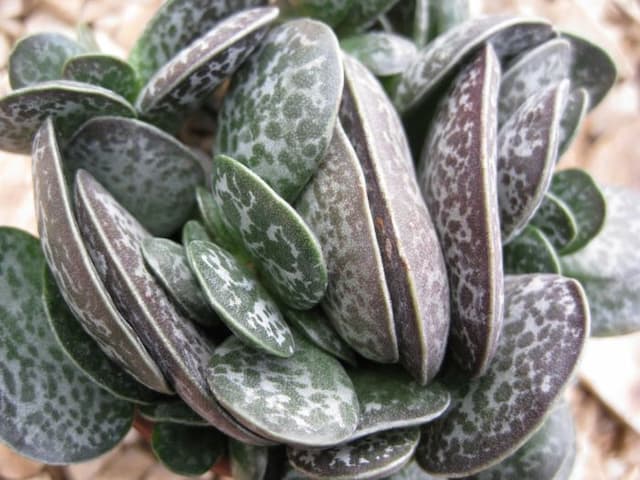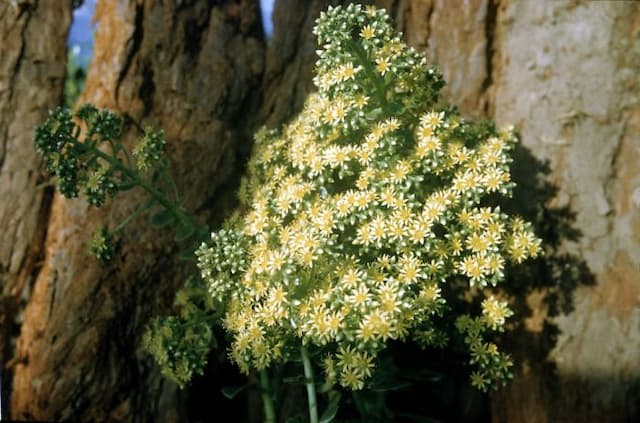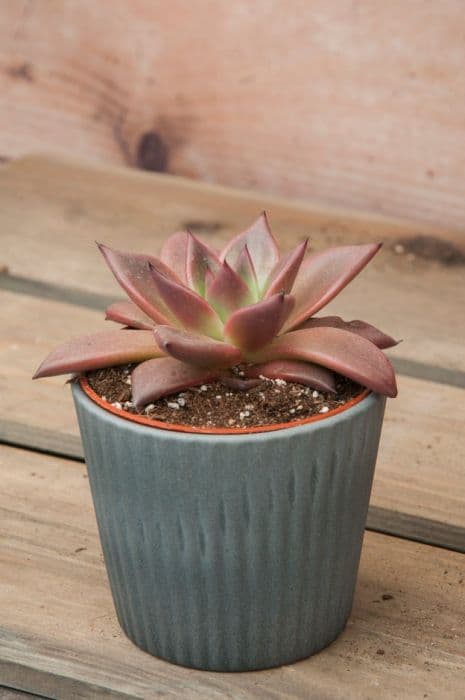Flower Dust Plant Kalanchoe pumila

ABOUT
Kalanchoe pumila, more commonly known as Flower Dust Plant, is a charming succulent that boasts an array of attractive features. It has a sprawling growth habit, with stems that branch out and can become densely covered in foliage. The leaves are a standout aspect of this plant, as they are fleshy and oval-shaped with a distinctive powdery coating that gives them a frosty, silver-gray appearance. This unique coating is not only visually striking but also helps to protect the plant from the sun. Edges of the leaves are often adorned with delicate, tiny pink to violet blooms that add a whimsical touch to the foliage. These flowers typically emerge in clusters, creating a lovely contrast against the silver-gray hue of the leaves. The blooms are bell-shaped and dangle gracefully from the tips of the branches, attracting pollinators such as bees and butterflies when in bloom. The Flower Dust Plant makes for an excellent addition to rock gardens, container plantings, or as a ground cover due to its low-lying and spreading nature. Its silvery foliage and dainty flowers make it a visually appealing choice for gardeners looking to add a touch of whimsy to their plant collection.
About this plant
 Names
NamesFamily
Crassulaceae.
Synonyms
Flower Dust Plant, Silver Gray.
Common names
Kalanchoe pumila.
 Toxicity
ToxicityTo humans
The plant commonly known as "Flower Dust Plant" is considered to have low toxicity to humans. However, ingestion of this plant can potentially cause mild gastrointestinal symptoms such as vomiting or diarrhea. It is not generally considered highly toxic to humans, but care should be taken to prevent small children from ingesting any parts of it as a precaution.
To pets
Flower Dust Plant is toxic to pets due to the presence of compounds known as bufadienolides, which can interfere with the heart's electrolyte balance. If a pet ingests parts of this plant, symptoms of poisoning may include vomiting, diarrhea, drooling, changes in heart rate, and potentially serious cardiac arrhythmias. If you suspect your pet has ingested this plant, consult a veterinarian promptly.
 Characteristics
CharacteristicsLife cycle
Perennials
Foliage type
Evergreen
Color of leaves
Silver
Flower color
Pink
Height
0 feet 8 inches (20 cm)
Spread
1 foot 0 inches (30 cm)
Plant type
Succulent
Hardiness zones
9
Native area
Madagascar
Benefits
 General Benefits
General Benefits- Decorative Appeal: Kalanchoe pumila, commonly known as Flower Dust Plant, showcases silvery-white foliage and pink flowers, adding aesthetic beauty to any garden or indoor space.
- Drought Tolerance: The Flower Dust Plant has succulent leaves that store water, making it highly drought-tolerant and well-suited to arid climates.
- Low Maintenance: Due to its hardy nature, it requires minimal care, making it ideal for gardeners with limited time or those new to plant care.
- Erosion Control: Its ability to spread across the ground helps stabilize soil and prevent erosion in certain outdoor environments.
- Pest Resistance: Kalanchoe pumila generally has a natural resistance to pests, reducing the need for chemical insecticides.
- Attracts Pollinators: When in bloom, the plant's flowers can attract beneficial insects like bees and butterflies to your garden.
 Medical Properties
Medical Properties- This plant is not used for medical purposes.
 Air-purifying Qualities
Air-purifying QualitiesThis plant is not specifically known for air purifying qualities.
 Other Uses
Other Uses- Ornamental Display: Kalanchoe pumila is often grown for its attractive foliage and flowers, making it a popular choice for rock gardens and as a border plant.
- Fairy Gardens: Due to its small size and whimsical appearance, it is frequently used to create fairy garden displays which are miniature and magical-themed gardens.
- Container Gardening: It is well-suited for container gardening due to its compact growth habit, where it can be displayed on patios or balconies.
- Succulent Arrangements: The silver-gray leaves and pink flowers of Kalanchoe pumila make it a charming addition to mixed succulent arrangements.
- Bonsai: Some enthusiasts use Kalanchoe pumila in bonsai cultivation, appreciating its miniature landscape when pruned and shaped accordingly.
- Hanging Baskets: Its trailing habit can be showcased in hanging baskets, where its flowers dangle attractively over the edges.
- Educational Projects: Schools and educational programs use this plant to teach students about succulent care and xeriscaping techniques.
- Photography: The unique look of Kalanchoe pumila makes it a favorite subject for plant photographers and Instagram posts.
- Craft Projects: The small flowers and leaves are sometimes used in craft projects, such as making botanical prints or adding natural elements to handmade cards.
- Culinary Garnish: Although not commonly consumed, the flowers may be used as an edible garnish on special dishes to add color, provided they have not been treated with pesticides.
Interesting Facts
 Feng Shui
Feng ShuiThe plant name is not used in Feng Shui practice.
 Zodiac Sign Compitability
Zodiac Sign CompitabilityThe plant name is not used in astrology practice.
 Plant Symbolism
Plant Symbolism- Resilience: Kalanchoe plants, including Kalanchoe pumila, are known for their ability to withstand harsh conditions and neglect, often symbolizing perseverance and the ability to thrive despite challenges.
- Longevity: With their succulent nature and long-lasting blooms, these plants are associated with enduring life and sometimes are given as gifts to wish someone a long and healthy life.
- Healing: Kalanchoes have medicinal properties and are used in traditional medicine, representing healing and the restoration of health.
- Prosperity: In some cultures, the kalanchoe is also seen as a symbol of wealth and prosperity, possibly because of its robust flowering ability.
- Love and Devotion: Often given as a gift, the kalanchoe's persistent blooms can be a symbol of enduring affection and commitment.
 Water
WaterFlower Dust Plant (Kalanchoe pumila) should be watered thoroughly when the soil is dry to the touch, approximately every 1 to 2 weeks depending on the environmental conditions. It is crucial to avoid overwatering, which can lead to root rot. When watering, use enough water to ensure that it runs through the drainage holes, which might be around 8–16 ounces for smaller pots. During the active growing season in spring and summer, you might water more frequently, reducing the amount in fall and winter when the plant's growth slows down.
 Light
LightFlower Dust Plant thrives in bright, indirect sunlight. An east or west-facing windowsill where it can receive a few hours of mild morning or late afternoon sun is ideal. Avoid placing it in direct, harsh sunlight, especially during the peak hours of the day, as this can scorch the leaves.
 Temperature
TemperatureThe ideal temperature range for Flower Dust Plant is between 60 to 85 degrees Fahrenheit. It can survive minimum temperatures of around 40 degrees Fahrenheit but should not be exposed to frost. Keeping the plant in a consistent temperature range without drastic fluctuations will promote healthy growth.
 Pruning
PruningPrune the Flower Dust Plant to maintain its shape and remove any dead or wilted leaves and stems. This should be done occasionally and is best performed in the spring or early summer when the plant enters its active growth phase. Pruning will also encourage bushier growth and prevent the plant from becoming leggy.
 Cleaning
CleaningAs needed
 Soil
SoilThe best soil mix for Flower Dust Plant is a well-draining, porous substrate with a mixture of 60% peat or coco coir and 40% perlite or sand. The optimal soil pH for Kalanchoe pumila should be in the range of 6.0 to 7.5 to ensure healthy growth.
 Repotting
RepottingFlower Dust Plant should be repotted every two to three years or when it has outgrown its current pot. It's important to use fresh soil mix when repotting to refresh nutrients.
 Humidity & Misting
Humidity & MistingFlower Dust Plant prefers low to average humidity levels, ideally between 40% to 60%. Excessive humidity can promote fungal growth and should thus be avoided for this succulent species.
 Suitable locations
Suitable locationsIndoor
For Flower Dust Plant, provide bright light, well-draining soil, and limited water.
Outdoor
Place Flower Dust Plant in bright shade, use well-draining soil, protect from frost.
Hardiness zone
9b-11 USDA
 Life cycle
Life cycleKalanchoe pumila, commonly known as Flower Dust Plant, begins its life cycle with seed germination, occurring in warm, well-draining soil under bright light. The seedlings then develop into juvenile plants, characterized by compact, silver-gray leaves dusted with powdery bloom. As the plant matures, it forms a robust succulent with a woody base and branching stems. The mature Flower Dust Plant undergoes a vegetative growth stage, during which it can produce offsets or be propagated through leaf cuttings. Seasonally, typically in late winter to early spring, the plant enters its reproductive stage, flowering with clusters of small, pink blossoms. After pollination, the plant sets seed, and if conditions allow, these seeds will disperse to begin the cycle anew, while the parent plant continues its growth or may enter a period of dormancy, depending on environmental factors.
 Propogation
PropogationPropogation time
Spring-Early Summer
The most popular method of propagating the Flower Dust Plant (Kalanchoe pumila) involves leaf cuttings. During spring or early summer, which is the plant's active growing period, select healthy, full-grown leaves from the Flower Dust Plant. Gently twist the leaf from the stem, ensuring a clean snap to include a small piece of the stem if possible. The leaf should be left to callous over for a day or two to form a thin, dry skin at the cut edge. After the callousing, place the leaf flat on well-draining potting mix or directly in sandy soil. Water sparingly, just enough to keep the soil slightly moist, and in about 2 to 3 weeks, you should notice small roots and shoots forming. These new plants can eventually be repotted into individual containers once they have developed a robust root system.









